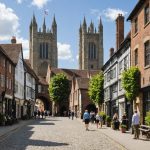Overview of Oxford’s Literary Significance
Oxford stands as a pillar of British literature, steeped in a rich literary heritage that has inspired countless authors and works. Known as an epicenter for literary excellence, its historical context as a literary hub is deeply entrenched. Oxford’s cobbled streets and ancient buildings have borne witness to the formation and cultivation of some of the most significant contributions to British literature.
Many notable authors have ties to Oxford, either as students or residents. The university has nurtured literary giants like J.R.R. Tolkien, C.S. Lewis, and Lewis Carroll, whose works form the bedrock of British literary culture. Tolkien and Lewis, in particular, are known to have frequented the famous Eagle and Child Pub, where they shared ideas and critiqued each other’s manuscripts.
This might interest you : Explore urban bivouac: a unique hotel experience in paris
Oxford’s significance in the broader scope of British literature cannot be understated. It has not only produced influential writers but also provided the backdrop against which numerous literary masterpieces have been conceived. This storied city continues to inspire new generations of writers, maintaining its status as a beacon of literary achievement. Aspiring authors often draw on Oxford’s rich literary heritage for inspiration, continuing the city’s age-old tradition of storytelling.
Key Literary Destinations in Oxford
Oxford entices literary enthusiasts with its array of mesmerizing destinations. Each site offers a glimpse into the city’s cultural tapestry and storied past.
Have you seen this : Explore the charm of japan posters and vintage art prints
Bodleian Library
As a central fixture among Oxford landmarks, the Bodleian Library is a must-visit for any literary aficionado. Established in 1602, it stands as one of Britain’s oldest libraries. With over 13 million printed works, its hallowed halls have been trodden by numerous eminent writers and scholars. Visitors are advised to take guided tours for a comprehensive experience, though advanced bookings are essential due to its popularity.
Christ Church College
Christ Church College melds architectural grandeur with rich literary history. Notably, its corridors inspired parts of Lewis Carroll’s ‘Alice in Wonderland’. The college’s breathtaking Great Hall is accessible to tourists, providing insights into its historical significance. Remember to check visiting hours, as some parts may close during University events.
The Eagle and Child Pub
Famed for its literary gatherings, the Eagle and Child Pub hosted regular meetings of the Inklings, including renowned figures like Tolkien and C.S. Lewis. Its historical ambiance offers a genuine taste of literary camaraderie. Open to the public, it remains a warm venue for those wishing to savour its vibrant past. Essential travel insight: arrive early to secure a spot.
The Influence of Oxford on Authors
Oxford’s laconic charm and historical backdrop have significantly moulded the works of numerous authors. The city’s diverse literary contributions are amplified by writers who not only studied but also deeply interacted with Oxford’s expansive intellectual landscape. J.R.R. Tolkien and C.S. Lewis frequently cited their time in Oxford as transformative, enriching their narratives with intricate layers reflective of their surroundings.
The city’s unique atmosphere fosters creativity, drawing on its ancient architecture and bustling scholarly community. The author influence in this context is notable; Oxford’s environment, with colleges nestled amidst picturesque settings, urges writers to explore themes of academia and philosophy.
Personal anecdotes further highlight this nurturing relationship. For instance, Lewis fondly recounted the stimulating discussions with fellow Inklings at the Eagle and Child Pub, events that deeply informed his writings. Such exchanges illustrate how Oxford’s culture of intellectual camaraderie ensures its continued influence on literature.
The literary contributions born out of Oxford confirm the city’s role as both a muse and a challenge, urging writers to think critically and expansively. This delicate balance nurtures storytelling that continues to resonate across generations.
Visitor Information and Practical Tips
Oxford offers a wealth of literary sites that beckon visitors. Navigating this rich cultural landscape requires practical insights. Firstly, optimal visiting periods are during spring and autumn, when the weather is mild, and the city’s charm is most vibrant. To explore comfortably, wearing sturdy shoes is recommended due to the cobbled streets prevalent in many areas.
For a seamless experience, pre-booking guided tours of famed locations like the Bodleian Library is advisable. These tours provide in-depth historical context and access to areas not available to the general public. Public transportation is convenient, with buses and bicycles offering efficient ways to navigate Oxford.
Maintaining decorum is crucial while visiting literary haunts. Respecting local customs and understanding visitor etiquette ensures a pleasant experience. For example, while in college grounds like Christ Church, refrain from noise as academic activities often occur.
Safety tips include staying aware of surroundings, especially in crowded areas. Engage with locals and other tourists for recommendations on hidden literary gems. By incorporating these practical tips, visitors can fully immerse themselves in the illustrious literary heritage of Oxford.
Itineraries for Literary Explorers
Embark on a journey through literary Oxford with thoughtfully crafted itineraries that maximise your experience. For those with limited time, a one-day walking tour offers a robust exploration of key sites. Begin your day at the awe-inspiring Bodleian Library, absorbing its historical grandeur before moving to the picturesque Christ Church College, where iconic literary figures once roamed its corridors. Spend your afternoon at the quaint Eagle and Child Pub, immersing yourself in the very atmosphere that fueled the creative dialogues of great authors like J.R.R. Tolkien.
Should you have additional days, opt for a multi-day literary exploration. Delve deeper into Oxford’s rich tapestry by visiting lesser-known literary landmarks, such as the Ashmolean Museum and Oxford University Press, each offering a unique perspective on the city’s literary narrative. Follow this with an exploration of nearby nature trails that inspired many poets.
Pairing these visits with a recommended reading list enhances the experience. Prepare by reading works directly associated with each location. This immersive approach bridges the gap between narrative and reality, enriching your understanding and appreciation for Oxford’s enduring literary legacy.
Visual and Cultural Context
Oxford’s cultural heritage is enriched by visuals that capture the essence of its literary sites. These visuals do more than just decorate; they communicate the city’s lush narrative heritage. Literary-themed documentaries offer immersive experiences, providing insights into how the city’s architecture and landscapes have inspired countless authors.
Oxford also hosts a series of cultural events and festivals that celebrate its rich literary tradition. These events, such as the Oxford Literary Festival, invite authors and enthusiasts alike to engage with literature in innovative ways. From panel discussions to immersive readings, these festivals are crucial in keeping the tradition vibrant and accessible.
For those who wish to take their exploration further, the city’s exhibitions offer a visual journey through its literary history. These include collections at museums like the Ashmolean, which showcase manuscripts and artifacts that connect directly to literary giants.
Engagement with Oxford’s literary sites through such mediums not only enriches the visitor’s experience but also cements an understanding of how this historic city serves as a perpetual muse for writers, both past and present.











